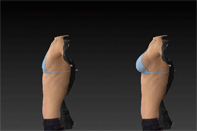If given the choice between a facelift that involved surgery or a liquid facelift, most people would probably opt for the liquid facelift. However, without an understanding of what a liquid facelift is and what it does, most of those people would probably be disappointed in the results.
This isn’t because a liquid facelift doesn’t work, because it can provide great results to those that would benefit from it, it’s because most people seeking out a facelift need more help than the liquid facelift can give.
A liquid facelift is a great way to help fix minor problem areas in people that wouldn’t necessarily require a full surgical facelift yet. It’s for younger people looking make minor adjustments to fat loss and small amounts of loose skin in the face and neck area. It’s not going to be the solution to fix major jawline issues or extreme sagging skin, but it can present a more youthful look overall.
What is a Liquid Facelift?
A liquid facelift technically is neither liquid nor a facelift. It is a minimally invasive procedure that uses injectables under the skin in the face and neck area, to help plump up certain problem areas. It can also help smooth out wrinkles around the eyes and in the folds between the nose and mouth.
A liquid facelift relies on injectable fillers like Radiesse, Restylane, Juvederm, and Sculptra to help fill in problem areas without having to undergo surgery. These fillers are injected under the skin to help replace fat and collagen that has been lost due to the aging process. It helps reduce that aging look that some people get as their skin begins to sag over time.
While this procedure is non-invasive, it still requires a needle to inject the fillers under the skin. Similar to the way that Botox is injected. In fact, when used in combination with Botox, patients tend to see better results.
But who will see the biggest benefit from a liquid facelift?
Patients in their 30s and 40s tend to respond best to the liquid facelift procedures as their skin still maintains a higher level of elasticity and the sagging and appearance of their face isn’t as drastic as someone in their 50s or 60s.
Now that’s not to say that a liquid facelift can’t be performed on older patients, it just means that the results may not be as good as a person may be expecting. Once the skin loses its elasticity and they lose more and more fat and collagen under the skin, adding fillers to the areas can cause the face to look bloated, puffy, and unnatural.
In these cases, a traditional surgical facelift is most likely the best option if you want to get the best results. But as with any surgical or non-surgical procedure, talk with your doctor before making any decisions on which method is right for you.
Benefits of a Liquid Facelift
The main benefit of a liquid facelift is that it is not a surgical procedure. Since the doctor will be using injectables as opposed to actually removing excess skin and tissue, the procedure is quicker, less uncomfortable, requires less recovery time, and is more cost effective.
However, because of those benefits you lose out on the longevity of the procedure. A liquid facelift will not last forever, whereas a traditional surgical facelift is more permanent and will last many years before you start to notice the effects of aging catching up with you.
The downside of the liquid facelift is that you’ll never be able to receive the results that you would get from a traditional surgical facelift, it’s not just possible.
How Long Does a Liquid Facelift Last?
As with most injectable procedures, the effects of a liquid facelift are only temporary. As time marches on, your body will slowly break down the fillers that have been injected into your body and you’ll start to lose the effect.
This process generally takes anywhere between 6 and 24 months, and depends on the type of filler used, where the filler was injected, and the amount of filler that was used. If you wish to maintain the look acquired after a liquid facelift, it would be best to setup a treatment plan with your doctor for regular visits.
How Much Does a Liquid Facelift Cost?
On average a liquid facelift can cost between $2000 – $7000 depending on how much work needs to be done, your geographical location, and other extraneous factors. But in most cases, you can expect to pay roughly somewhere between these amounts.
A traditional facelift can range between $7500 – $15000 depending on the location of the surgeon, the surgeon themselves, and how much work is required to achieve the desired results.
As you can see, a traditional facelift comes at a much steeper cost as well as a longer recovery period.
Liquid Facelift vs. Traditional Surgical Facelift
Both procedures have their pros and cons, but the important thing to remember is to listen to your doctor or surgeon. They have been performing these procedures for a long time and have firsthand experience with the results.
They will be able to give you a better understanding of whether or not you would even see the benefits of a liquid facelift, or if a surgical facelift would give you the results you’re looking for. There’s nothing worse than going through a non-surgical procedure expecting the results to look one way, and then being disappointed with how they actually turned out.
Liquid facelifts are not going to bring your face and neck back to what they were when you were in your 20’s, but if you’re looking for minor improvements as you reach your 30’s and 40’s, this procedure is a great way to bring back some of that youthfulness you may have lost over the years.















